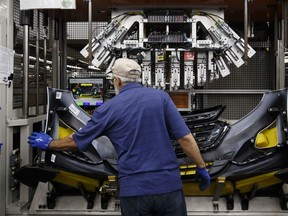Any tariffs would come just as Canada’s auto production is bouncing back
Article content
Canada’s automobile executives are anxiously waiting to see if Donald Trump makes good on threats to impose 25 per cent tariffs on all Canadian imports after he assumes his second term as United States president in January.
Article content
Article content
More than 91 per cent of Canadian automotive and auto parts are exported to the U.S., and some parts cross the U.S. or Mexico border as many as eight times before they are installed in a final assembly.
Advertisement 2
Article content
That means the stakes are high for an industry that is already being destabilized by the costs and uncertainties of making the electric vehicle transition, considered one of the largest industrial transformations in history.
What’s more, industry insiders say the auto sector is still reeling from several years of other challenges, such as semiconductor shortages that depressed production and high interest rates and inflation that reduced consumer demand.
As a result, many auto industry insiders are on edge about the impacts of a 25 per cent tariff.
“Looking at the history with Trump and his negotiating tactics, it is fairly clear that it’s a threat to start some conversation,” James Carter, a consultant to the sector at Vision Mobility based in Toronto and a former Toyota Motor Corp. sales and marketing executive, said.
“Will this happen? That’s a very good question, but I think it’s really worth thinking about how intertwined Canada, Mexico and the U.S. are … specifically on automotive, where just so much crosses the border, and it’s many, many, many billions of dollars, probably monthly.”
Article content
Advertisement 3
Article content
The threat of tariffs, as articulated by Trump on social media, has so far lacked concrete details.
On Nov. 25, he said on his social media platform Truth Social that one of his first executive orders will be to implement 25 per cent tariffs on all products coming into the U.S. from Canada and Mexico in retaliation for the illegal immigrants and drugs that come across the borders.
Any tariffs would come just as Canada’s auto production is bouncing back. Total vehicle production in the country had been slowly bouncing back to nearly two million vehicles after hitting a low point in 2021 of around 1.1 million vehicles as a result of various supply chain and pandemic-related challenges, according to CEIC Data, a private macroeconomics firm, and TD Economics.
Trump imposed tariffs on Canadian steel and aluminum of 25 per cent and 10 per cent, respectively, in his last term.
He first imposed tariffs on aluminum, about 40 per cent of which in Canada is used by the auto sector, in June 2018 and they lasted until May 2019. They were then reimposed in August 2020, but ended the following month.
Advertisement 4
Article content
Those tariffs caused short-term disruptions for both steel and aluminum exports to the U.S., but export levels rebounded within two to three years, according to a Bank of Nova Scotia report issued earlier this month.
That history has many convinced Trump will follow through on his threat to impose blanket 25 per cent tariffs.
Some say the International Emergency Economic Powers Act gives a U.S. president broad authority to regulate economic issues through executive orders — meaning it would allow Trump to impose tariffs without an act of Congress.
The hope is that such tariffs will be short-lived, said one industry insider, who asked not to be named because of the sensitive nature of the topic. He said auto companies have likely already started stockpiling inventory in the U.S. to avoid the impacts of the tariffs.
“What we’re trying to talk about with members right now is to exercise a little patience,” said Collin Shaw, president of the Motor & Equipment Manufacturer’s Association, a trade organization that represents auto-parts companies throughout North America.
Advertisement 5
Article content
He said his members’ profitability has fallen in recent years due to several factors, including increases in the price of raw materials as a result of inflation and increases in the cost of labour.
But when it comes to how long tariffs could last and whether they’ll be implemented, he said there was only uncertainty.
“At this point, it’s all guesswork,” Shaw said. “All I know is we have a lot of members that leverage the entire ecosystem” in North America.
Jean Simard, president of the Aluminum Association of Canada, a Montreal-based trade organization, said the impacts of the last round of tariffs were acute for U.S. consumers, and that would likely be the case again with any new tariffs.
“It’s going to be very damaging to downstream users in the U.S.,” he said about aluminum.
Recommended from Editorial
-

Trump tells EU to buy U.S. oil and gas or face tariffs
-

Ford pleads to Trump on tariffs
-

U.S. oil sector pushes Trump to spare it from tariffs
Automakers absorb the cost increase, he said, and then it has to be passed on to the consumer.
“Your Ford F-150 is going to cost more,” Simard said.
• Email: gfriedman@postmedia.com
Bookmark our website and support our journalism: Don’t miss the business news you need to know — add financialpost.com to your bookmarks and sign up for our newsletters here.
Article content
Trump’s tariff threats rattle Canada’s auto industry
2024-12-20 16:06:08







